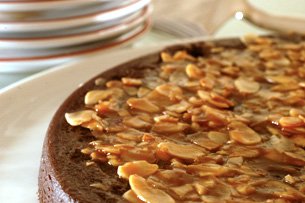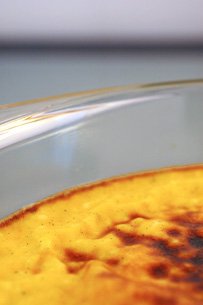
[Aunt Amélie’s Smooth Chocolate Cake]
None of my aunts are named Amélie, I thought I should make that clear from the start. And if I am to explain the origin of this recipe, I will need to rewind the tape back to early January, when French food writer Thierry Roussillon asked if I would answer a few questions for one of the interviews gourmandes he publishes on his blog.
A few days after I did, a severe bout of procrastination found me browsing through other people’s interviews. I happened upon that of Augustin, of Michel et Augustin fame, who made a passing mention of “le fondant de Tante Amélie, un gâteau au chocolat épatant cuit au bain-marie” — “Aunt Amélie’s smooth cake, a stupendous chocolate cake cooked in a water bath.”
Stupendous? Smooth? Chocolate? And a novel technique? My curiosity itched so badly it had to be soothed with tiger balm. I called Augustin and asked in my sweetest voice if he was willing to share the recipe — provided it didn’t break any sort of culinary omertà of course. He was, it didn’t (Amélie is in fact the aunt of Augustin’s wife, Victoire, which leaves us with a pretty daisy chain of French names), and I gave the recipe a whirl at the first opportunity.
It is indeed an unusual, and very easy recipe that begins with a sirop de sucre (a syrup of equal parts water and sugar) in which you melt the chocolate and butter. As for the hot water bath, its role is to conduct the heat gently around the pan, resulting in a smooth crustless texture that swathes your tongue.
And so I had made the cake and set it to cool, the kitchen counter had been cleared and I was taking a minute to admire the finished product, my head slightly tilted to the right, when it occured to me that something was missing. My cake looked naked.
Now, as regular readers may have noted, I rarely submit my cakes to the suffocating torments of frostings, icings, or glazes: I prefer the looks of a simple cake, and I don’t enjoy the mouthfeel (nor the extra work) of most frostings. But if I was going to serve this one to company — and company was expected any minute — it really needed some sort of headdress.
This is when I remembered that Les Petits Mitrons — a pastry shop on rue Lepic that specializes in beautifully old-fashioned but excessively caramelized fruit tarts — sells a similar chocolate cake that is decorated with a shiny topping of sliced almonds.
I wasn’t certain how they achieved that finish, but I opted for an abricotage, the trick that makes classic French fruit tarts so glossy: you combine two parts apricot jam with one part water, heat gently until thin, fish out any bit of apricot skin, and brush lightly over your tart or cake or body.
I didn’t have apricot jam on hand, but I did have a half-eaten (no: half-full) jar of Christine Ferber‘s strawberry and mango jam, and that worked splendidly. I toasted a handful of sliced almonds, stirred them into the mangofraisage, and spooned that atop the cake, which I served with mango sorbet, to soft moans of approval from my dinner companions.
Continue reading »








